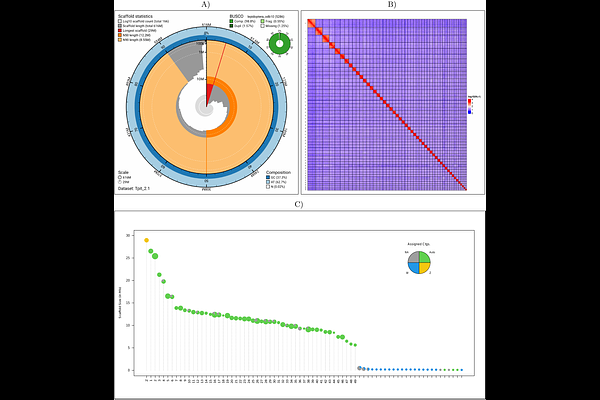A Chromosome-Level Assembly of the Pine Processionary Moth (Thaumetopoea pityocampa) genome

A Chromosome-Level Assembly of the Pine Processionary Moth (Thaumetopoea pityocampa) genome
Gautier, M.; Nouhaud, P.; Lagnel, J.; Saune, L.; Legeai, F.; Parinello, H.; Gschloessl, B.; Marande, W.; Lopez-Roques, C.; Dorkeld, F.; Branco, M.; Perrier, C.; Kerdelhue, C.
AbstractWe present a chromosome-level genome assembly and annotation of the pine processionary moth, Thaumetopoea pityocampa (Lepidoptera: Notodontidae), a key forest pest that is a public health concern. The nuclear genome spans 615.9 Mb, scaffolded into 50 chromosome scale and 115 smaller scaffolds, with high completeness (BUSCO score: 98.9%) that provides a decisive improvement over the previous assembly (537 Mb; 68,292 contigs; BUSCO 83.6%). Coverage differences in resequenced males and females allowed identification of the Z chromosome and several W-linked contigs. As expected from previous studies, we found that synteny was largely conserved with related Lepidoptera, although chromosomal fissions may explain the higher chromosome number of 49 autosomes compared to typical lepidopteran karyotypes. We also integrated into the assembly linkage map, allowing estimation of a genome-wide male recombination rate of 5.06 cM/Mb, varying from 11.6 cM/Mb to 1.98 cM/Mb from the smallest to the largest chromosomes. Repetitive elements represented 49.1% of this new assembly, dominated by LINEs (45.1% of classified repeats). Finally, gene prediction identified 12,898 gene models, among which 17 circadian rhythm genes were manually curated. Overall, this assembly represents the first chromosome-level genome for a member of the Thaumetopoeinae subfamily, significantly expanding the currently limited set of genomic resources available for Notodontidae. The fully annotated assembly is publicly accessible through the LepidoDB database (https://bipaa.genouest.org/is/lepidodb/) and will serve as a valuable resource for research on population genomics of this species.